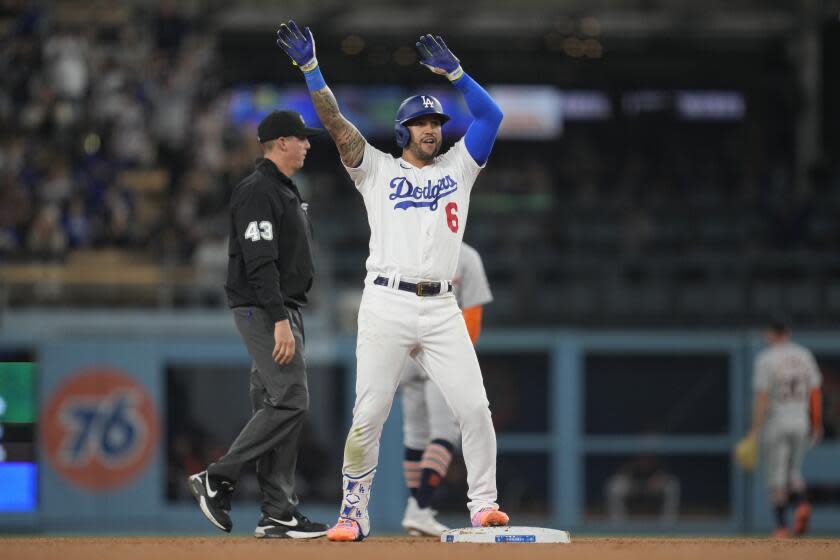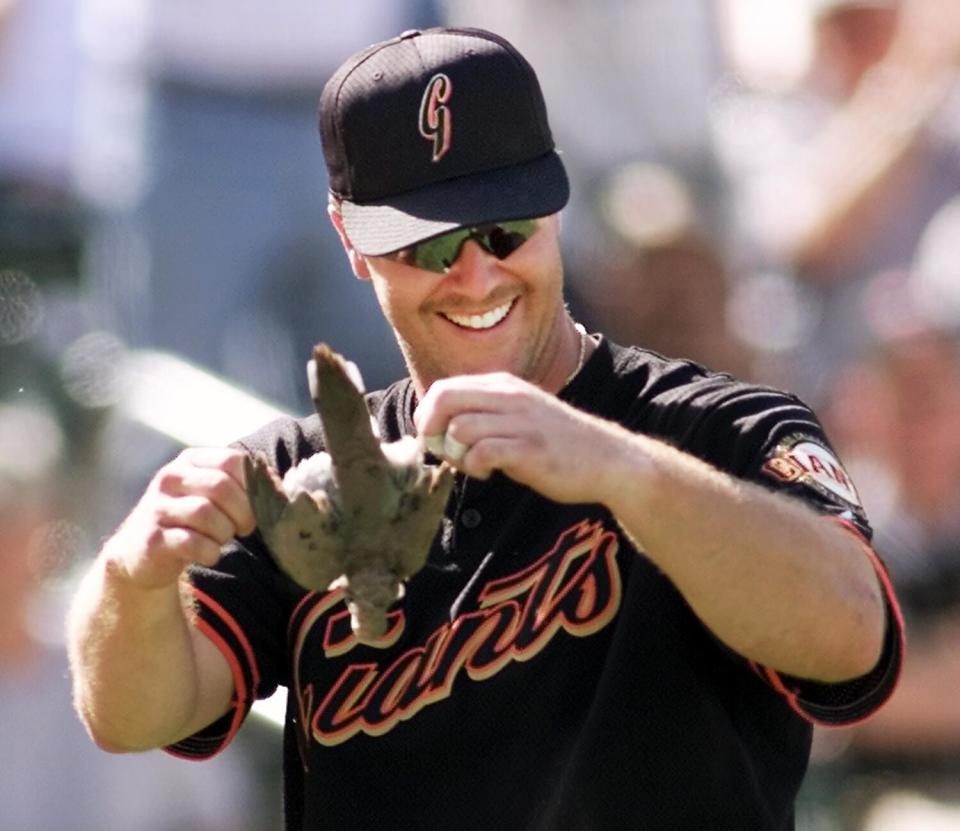Dodgers' foul ball nearly kills a goose. Is sighting an omen of another playoff disaster?

- Oops!Something went wrong.Please try again later.
- Oops!Something went wrong.Please try again later.
- Oops!Something went wrong.Please try again later.
The moment produced pause, puns and fun on the fly. Oh, and reminders of a similar intrusion that immediately preceded the Dodgers’ demise in last year’s National League Division Series.
David Peralta lifted a towering fly ball down the left-field line in fowl, er, foul territory Wednesday against the Detroit Tigers that nearly struck a duck. Or was that a goose on the loose? Turns out either name is accurate.
We fly high, no lie, you know this, Birdin’. 🐦 pic.twitter.com/mhH3sgqPqN
— MLB (@MLB) September 21, 2023
Consensus from those using the nifty phone app Picture Bird: Birds Identifier is that the rather enormous creature — Dodgers broadcaster Joe Davis joked that it was a pterodactyl — gracefully circling through Dodger Stadium was an Egyptian goose (Alopochen aegyptiaca), an African member of the duck family Anatidae. Breeding populations in the United States have been established after the popular ornamental bird escaped captivity in several states, including California.
Dodgers — and San Diego Padres — fans might recall when a goose made a rough landing in shallow right field at Dodger Stadium during the seventh inning of Game 2 of the NLDS last year. So, while the presence of the goose Wednesday night might prove birds of a feather do indeed flock together, a more ominous connection was made on social media.
Read more: What happened to the goose that stole all the attention at Dodgers playoff game?
The Dodgers had won an astounding 111 regular-season games and Game 1 of the 2022 NLDS, yet they ran out of juice after taking a gander at the goose, losing three in a row to the Padres for an unceremonious postseason exit.
For the record, last year's bird was identified as a greater white-fronted goose by Travis Longcore, president of the Los Angeles Audubon Society. Geese of all sorts have overrun nearby Echo Park Lake, so Dodgers fans shouldn't be surprised by more sightings.

Peralta's near miss made the episode less than tragic. The probability of a baseball actually striking a bird in flight must be astronomical, but sadly it has happened at least three times — including twice in one week this season. The first and most famous occurrence came in 2001, when Hall of Fame left-hander Randy Johnson killed a dove that happened to fly in the path of a pitch.
Read more: Photos: Goose gets loose as Dodgers lose to Padres in Game 2 of NLDS series
Twenty-two years later, Arizona Diamondbacks pitcher Zac Gallen killed a bird with a warmup pitch during a game May 17. Less than a week later, a line drive by Cleveland Guardians' Will Brennan killed a bird.
As for an omen of another October disaster by the Dodgers, the easy prediction would be that the Baltimore Orioles are destined to defeat them in the World Series. But in addition to the goose sighting, another incident occurred Wednesday during the Dodgers' 4-2 loss to the Tigers that screamed symbolism.
Stop on your right foot, don’t forget it!
A bubble delay at Dodger Stadium. 🫧 pic.twitter.com/zzSHJrjbF4— MLB (@MLB) September 21, 2023
Something strange hovered over the outfield, causing a brief delay. Dodgers center fielder James Outman was spot on when he looked skyward and said, "It's a bubble." Could it be an all-too-obvious metaphor for the team's mesmerizing ability to win despite a starting rotation as thin as the soapy film that traps air inside a you-know-what?
The bubble, of course, burst.
Read more: The top playoff seed is up for grabs, but the Dodgers aren't changing their approach
This story originally appeared in Los Angeles Times.

